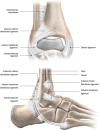Return to Play After a Lateral Ligament Ankle Sprain
- PMID: 32377961
- PMCID: PMC7251008
- DOI: 10.1007/s12178-020-09631-1
Return to Play After a Lateral Ligament Ankle Sprain
Abstract
Purpose of review: The purpose of this review is to describe the current evidence on the most common sports-related ankle injuries. Joint anatomy, epidemiology, clinical findings, diagnostic approach, and treatment are presented with a specific focus on the available evidence towards return to play.
Recent findings: Recent findings show that ankle sprain is the most common injury in the world of sports. Bony fractures, cartilage defects, and syndesmotic lesions are frequently seen in association with the more severe type of ankle sprains. In summary, the majority of the athletes' ankle sprains are managed conservatively with excellent outcomes and full return to their pre-injury level of play. However, it is essential to differentiate the single ligament sprain from a more complex injury to the ankle joint. The evidence-based treatment and rehabilitation programmes are associated with a better prognosis and a faster time to return to sport participation.
Keywords: Ankle injuries; Ligament injuries; Rehabilitation; Return to play.
Conflict of interest statement
Pieter D’Hooghe, Flavio Cruz, and Khalid Al Khelaifi declare that they have no conflict of interest.
Figures
References
-
- Cloke DJ, Ansell P, Avery P, Deehan D. Ankle injuries in football academies: a three-centre prospective study. Br J Sports Med. 2011;45(9):702–708. - PubMed
-
- Giza E, Fuller C, Junge A, Dvorak J. Mechanisms of foot and ankle injuries in soccer. Am J Sports Med. 2003;31(4):550–554. - PubMed
-
- Cloke DJ, Spencer S, Hodson A, Deehan D. The epidemiology of ankle injuries occurring in English football association academies. Br J Sports Med. 2009;43(14):1119–1125. - PubMed
-
- Jain N, Murray D, Kemp S, Calder J. Frequency and trends in foot and ankle injuries within an English premier league football club using a new impact factor of injury to identify a focus for injury prevention. Foot Ankle Surg. 2014;20(4):237–240. - PubMed
-
- Waldén M, Hägglund M, Ekstrand J. Time-trends and circumstances surrounding ankle injuries in men’s professional football: an 11-year follow-up of the UEFA champions league injury study. Br J Sports Med. 2013;47(12):748–753. - PubMed
Publication types
LinkOut - more resources
Full Text Sources
Medical
Research Materials




